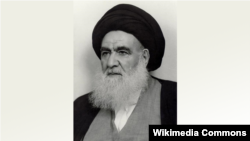Hassan Rouhani’s trip to Iraq was discussed from various angles by observers, but few noticed that he did not carry any greetings from Iran’s Supreme Leader Ali Khamenei to the highest religious leader of Shiites, Grand Ayatollah Ali al-Sistani of Najaf.
Likewise, when Rouhani returned to Iran he did not carry any message from Sistani, who is also originally from Iran, to Khamenei.
One is a religious and political leader in Iran and the other is regarded as the highest spiritual authority for Shiites in Iraq and beyond.
It is odd, to say the least, that no news emerged about an exchange of messages, or at a minimum, a simple greeting between the two influential leaders of the same denomination.
After all, Rouhani is the president of the only official Shia country in the world and he is a clergyman. It is surprising he did not convey Khamenei’s greetings to Sistani, something that would have been reported by at least one of the parties.
The answer to this puzzle lies in the differences between the Shia Jurisprudence of Najaf, the oldest Shiite religious center and Qom, the relatively new contender in Iran.
Najaf has a millennial history, while Qom was established less than a century ago as a religious rival to Najaf. However, due to the Islamic Republic’s resources, it is now considered an important point of gravity for Shiites.
Qom’s only advantage is its political sway, which it acquired just forty years ago when Ayatollah Rouhollah Khomeini overthrew the monarchy and appointed himself as the all-powerful leader of the first Shiite clergy-run state in history.
The differences of these two religious centers are not new. Ayatollah Abu al-Qasim Khoei, the spiritual leader of Shiites in Iraq, until his death in 1992 refused to get involved in politics. He only gave advice to political leaders and never uttered a word against Iran’s last monarch, Mohammad Reza Shah Pahlavi.
In contrast, Khomeini who represented Qom was a political Islamist, who led the Iranian revolution and pushing all revolutionaries aside, became the absolute ruler of Iran.
Khoei never sent a congratulatory message to Khomeini for the establishment of the Islamic Republic and never got involved with the Iran-Iraq war. He also happened to be from Iran.
Khoei, devoted to non-political Islam, remained a respected religious scholar and leader and passed this tradition on to Sistani.
In other words, these two worldviews differed in how they perceived Islam. Najaf was non-political and Qom, especially after 1979, was all about politics. Not only Khomeini established the Islamic Republic, he became commander in chief of Iranian armed forces, an unheard of proposition for Shiite clerics – at least since the 8th century.
The story is completely different with Sunni Islam, as the first Caliphates were founded on the basis of religion and religious legitimacy. The emergence and the essence of Shias on the other hand was their refusal to accept the Sunni model and the apolitical style of their clergy continued for centuries.
With the coming of Khomeini, political Shiism emerged with full force, almost as a copy of the Sunni Muslim Brotherhood. It is no accident that Khamenei translated two Brotherhood books into Persian when he was a young clergyman.
Interestingly, Egypt’s Muslim Brotherhood which initially had welcomed the birth of the Islamic Republic quickly distanced itself from Khomeini’s realm. Mohammad Morsi who was the only Brotherhood member to become president of Egypt, visited Tehran for a few hours in 2012, but he did not meet with Khamenei.







